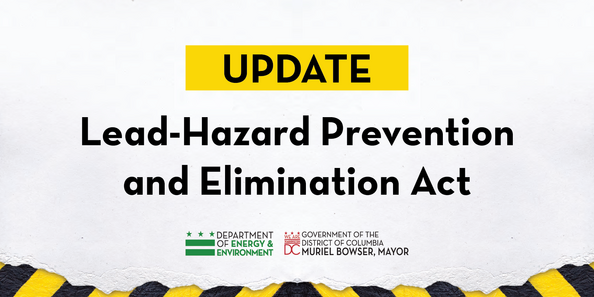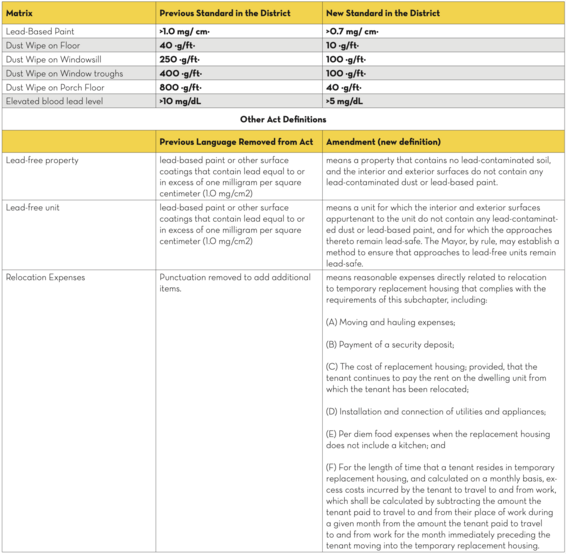The Department of Energy and Environment (DOEE) has made another pivotal step in making the District lead-safe and reducing childhood lead poisoning. D.C. Council has made changes to key regulatory definitions in the Lead-Hazard Prevention and Elimination Act (Act). The numeric thresholds for what is considered lead-based paint or a lead dust hazard have been lowered to better protect District residents. DOEE has already begun the process of implementing most of these changes. The regulated community must incorporate these changes by August 1, 2023. Amendments to the Lead-Hazard Prevention and Elimination Act are included in D.C. Law 23-188. Residential Housing Environmental Safety Amendment Act of 2020. | D.C. Law Library (dccouncil.gov). The amendments are listed below. View the Act in its entirety here.
- “Elevated blood lead level” means the concentration of lead in a sample of whole blood equal to or greater than 5 micrograms of lead per deciliter (µg/dL) of blood, or such more stringent standard as may be established by the U.S. Centers for Disease Control and Prevention as the appropriate level of concern, or adopted by the Mayor by rule.
- “Lead-based paint” means any paint or other surface coating containing lead or lead in its compounds in any quantity exceeding 0.5% of the total weight of the material or more than 0.7 milligrams per square centimeter (0.7 µg/cm²), or such more stringent standards as may be specified in federal law or regulations promulgated by EPA or HUD, which shall be adopted by the Mayor by rule.
- “Lead-contaminated dust” means surface dust based on a wipe sample that contains a mass per area concentration of lead equal to or exceeding:
- (A) For dust action levels or for the purpose of clearance examination:
- (i) 10 micrograms per square foot (“µg/ft²”) on floors; or
- (ii) 100 µg/ft² on interior windowsills;
- (B) For the purpose of clearance examination:
- (i) 100 µg/ft² on window troughs; or
- (ii) 800 µg/ft² on concrete or other rough exterior surfaces;
- (iii) 40 µg/ft² on porch floors; or
- (C) Such more stringent standards as may be:
- (i)(I) Specified in federal law; or
- (II) Specified in regulations promulgated by the United States Environmental Protection Agency or the United States Department of Housing and Urban Development; or
- (ii) Adopted by the Mayor by rule.
- (i)(I) Specified in federal law; or
- (A) For dust action levels or for the purpose of clearance examination:
- “Lead-free property” means a property that contains no lead-contaminated soil, and the interior and exterior surfaces do not contain any lead-contaminated dust or lead-based paint.
- “Lead-free unit” means a unit for which the interior and exterior surfaces appurtenant to the unit do not contain any lead-contaminated dust or lead-based paint, and for which the approaches thereto remain lead-safe. The Mayor, by rule, may establish a method to ensure that approaches to lead-free units remain lead-safe.
- “Relocation expenses” means reasonable expenses directly related to relocation to temporary replacement housing that complies with the requirements of this subchapter, including:
- (A) Moving and hauling expenses;
- (B) Payment of a security deposit;
- (C) The cost of replacement housing; provided, that the tenant continues to pay the rent on the dwelling unit from which the tenant has been relocated;
- (D) Installation and connection of utilities and appliances;
- (E) Per diem food expenses when the replacement housing does not include a kitchen; and
- (F) For the length of time that a tenant resides in temporary replacement housing, and calculated on a monthly basis, excess costs incurred by the tenant to travel to and from work, which shall be calculated by subtracting the amount the tenant paid to travel to and from their place of work during a given month from the amount the tenant paid to travel to and from work for the month immediately preceding the tenant moving into the temporary replacement housing.
The regulated community must incorporate these changes by August 1, 2023.
Article source: Department of Energy and Environment Government of the District of Columbia


